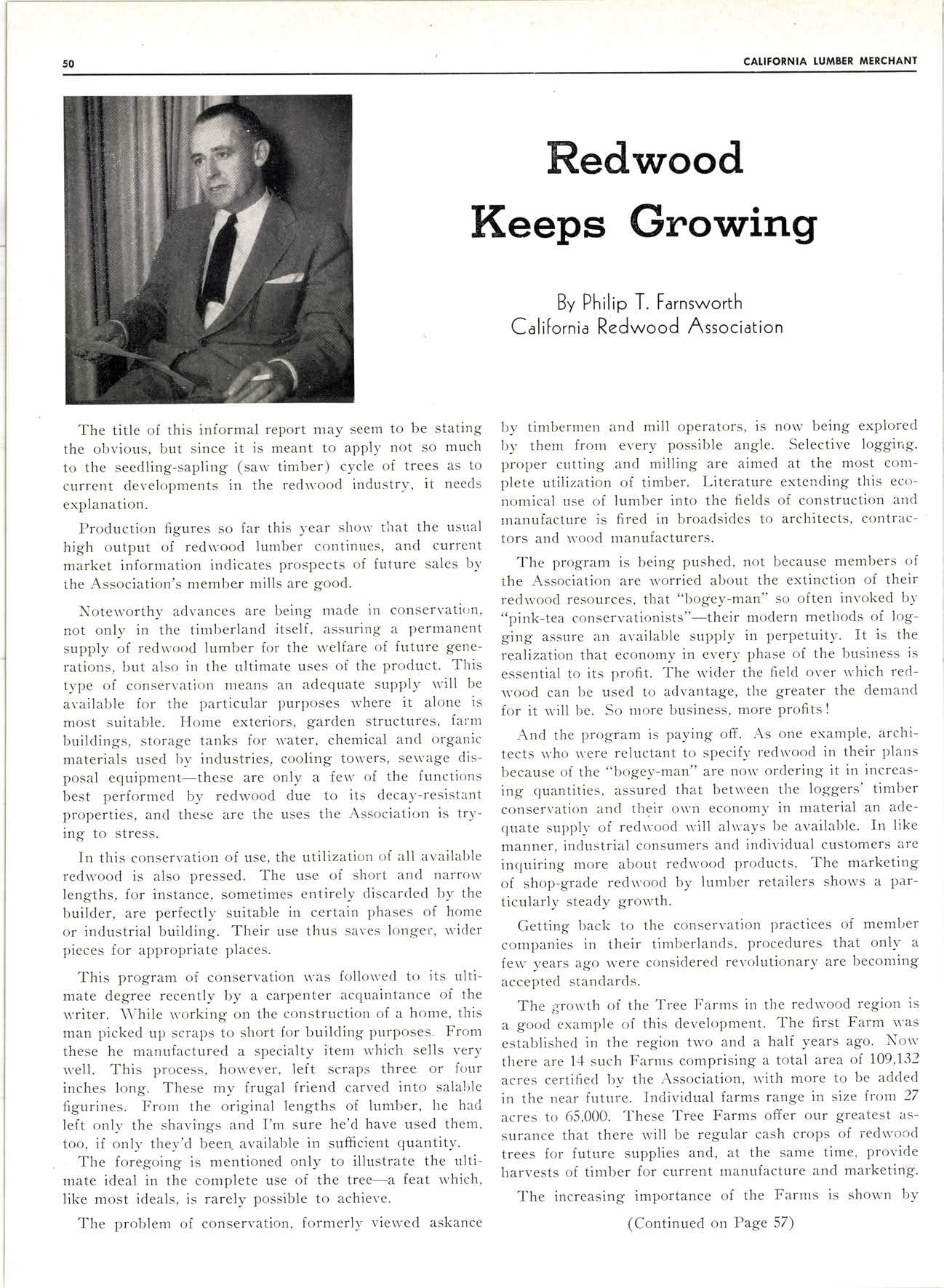
3 minute read
Redwood Keeps Growing
Bv Philip T. Farnsworth
Calilornia Redwood Association
The title of this informal report may seem to be stating the obvious, but since it is meant to apply not so much to the seedling-sapling (sarv timber) cycie of trees as to current developments in the redrt'ood industry, it needs explanation.
Production figures so far this year shorv that the usual high output of redrn'ood lumber continues, and current market information indicates prospects of future sales bv the Association's member mills are good.
Notervorthy advances are being made in conservatit;n, not only in the timberland itself, assuring a permanent supply of redu'ood lumber for the welfare of future generations, but also in the ultimate uses of the product. This type of conservation means an adequate supply will be available for the particular purposes where it alone is most suitable. Home exteriors, garden structttres, farm buildings, storage tanks for water, chemical and organic materials used by industries, cooling to$'ers, sewage disposal equipment-these are only a few of the functions best performed by redwood due to its decay-resistant properties, and these are the uses the Association is trying to stress.
In this conservation of use, the utilization of all available redwood is also pressed. The use of short and narrolv lengths, for instance, sometimes entirely discarded by the builder, are perfectly suitable in certain phases of home or industrial building. Their use thus saves longer, rvider pieces for appropriate places.
This program of conservation 'was follorved to its ultimate degree recently by a carpenter acquaintance of the u'riter. While u'orking on the construction of a home, this man picked up scraps to short for building purposes. From these he manufactured a specialty item which sells very n'ell. This process, however, lef t scraps three or four inches long. These my frugal friend carved into salable figurines. From the original lengths of lumber, he had left only the shavings and I'm sure he'd have used them, too, if only they'd been available in sufficient quantity.
The foregoing is mentioned only to illustrate the ultimate ideal in the complete use of the tree-a feat which, like most ideals, is rarely possible to achieve.
The problem of conservation, formerly viewed askance by timbermen and mill operators, is now being explored by them from every possible angle. Selective logging, proper cutting and milling are aimed at the most complete utilization of timber. Literature extending this economical use of lumber into the fields of construction and rnanufacture is fired in broadsides to architects, contractors and u'ood tnanufacturers.
The program is being pushed, not because members of the Association are 'ivorried about the extinction of their redwood resources, that "bogey-man" so often invoked by "pink-tea conservationists"-their modern methods of logging assure an available supply in perpetuity. It is the realization that economy in every phase of the business is essential to itsprofit. The wider the field over rvhich redu,ood can be used to advantage, the greater the demand for it will be. So more business, more profits !
And the program is paying off. As one example, architects lvho u'ere reluctant to specify redrvood in their plans because of the "bogey-man" are now ordering it in increasing quantities, assured that betn'een the loggers' timber conservation and their ou'n economy in material an adequate supply of redrvood rvill alu'ays be available' In like manner, industrial consumers and individual customers are incluiring more about redwood products. The marketing of shop-grade redrvood by lumber retailers shows a particularly steady growth.
Getting back to the conservation practices of member companies in their timberlands, procedures that onlv a few years ago were considered revolutionary are becoming accepted standards.
The gron'th of the Tree Farms in the redwood region is a good example of this development. The first Farm rvas established in the region two and a half years ago' Norv tlrere are 14 such Farms comprising a total area of 109,132 acres certified by the Association, 'ivith more to be added in the near fnture. Individual farms range in stze lrom 27 acres to 65,000. These Tree Farms offer our greatest assurance that there will be regular cash crops of redrvood trees {or future supplies and, at the same time, provide harvests of timber for current manufacture and marketing.
The increasing importance of the Farms is shown by (Continued on Page 57)










